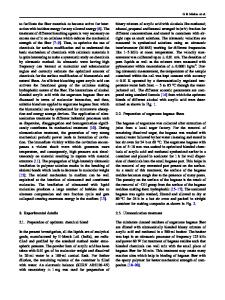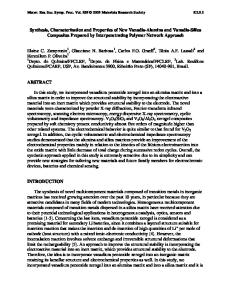Synthesis and material characterization of beryllium/Ti-6Al-4V composites
- PDF / 1,946,869 Bytes
- 7 Pages / 612 x 792 pts (letter) Page_size
- 35 Downloads / 468 Views
Two materials which could be combined to form a composite system optimizing these properties are beryllium and Ti-6A1-4V. T a b l e I shows typical mechanical properties for t h e s e phases. Both m a t e r i a l s exhibit good ductility with beryllium offering a high specific elastic modulus but moderate tensile p r o p e r t i e s and a low fracture toughness. The Ti-6A1-4V alloy compensates for the inferior beryllium properties by t r a d i n g off a relatively low elastic modulus for a good specific strength and acceptable fracture toughness. SPECIMEN PREPARATION AND MICROSTRUCTURAL CHARACTERIZATION The experimental p r o g r a m for fabricating such a composite involved conventional powder metallurgy techniques, viz: powder blending the elemental constituents, consolidating the powder mixture to ~95 pct of theoretical density, and extruding t o final shape. The process involved blending commercially a v a i l able Be and Ti-6A1-4V powders t o produce t h r e e different composite structures, i.e., 60 vol pct Be, 50 vol pct Be and 40 vol pct Be. In addition, pure b e r y l lium and Ti-6A1-4V specimens were fabricated t o evaluate elemental m a t e r i a l properties under fixed processing conditions. Consolidating the powder blends involved capsulating a compact in thin gage mild s t e e l and evacuating the assembly. The assemblies were isostatically consolidated u s i n g hot a r g o n at 103 M P a (15 ksi). The limiting temperature in this operation was less than 700°C, and the processing conditions were adjusted t o avoid appreciable formatiou of an intermetallic TiBe12 reaction zone between the Be and Ti-alloy phases. Formation of this inherently brittle p h a s e at the Be/Ti-alloy i n t e r f a c e s results in a m a r k e d degradation in mechanical properties. Typical composite structures a f t e r initial consolidation are shown in Fig. 1; porosity in the composite at this s t a g e of consolidation is effectively confined t o the Ti-6A1-4V (light phase). In addition, the structure shows occasional cleavage c r a c k s in the Be phase with the likelihood that cleavage was nucleated at the interface and propagated a c r o s s the Be phase. This is attributed to the residual s t r e s s at the interface resulting from differential t h e r m a l contraction between the two phases. The Be phase contracts approximately 10 pct more than the Ti-alloy phase over the same temperature increment, and this VOLUME 8A, JANUARY 1977-179
T a b l e I . Typical Mechanical Properties o f B e a n d T i - 6 A I - 4 V
Material Beryllium (rolled sheet) Ti-6A1-4V
Tensile Strength,at MPa (ksi)
Yield 0.2 Pct Offset MPa (ksi)
Charpy V-Notch, -40°C J (ft-lbs)
Young's Modulus, E GPa (106 psi)
E/p
1.85
303
(44)
163
482
(70)
260
345
(50)
10
0.31
(0.23)
4.54
110
(16)
24
1240
(180)
274
1102
(160)
14
8.70
(6.40)
Specific Gravity, p
GPa
-
t~ ~%
$41"
*
•
4 0
"
at/p
MPa
Elongation, Pct
p a t h i s d e f i n e d by i n t e r f a c e s e p a r a t i o n b e t w e e n p h a s e s a n d by o c c a
Data Loading...











